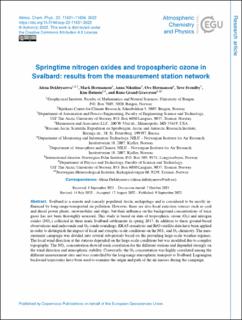| dc.contributor.author | Dekhtyareva, Alena | |
| dc.contributor.author | Hermanson, Mark H. | |
| dc.contributor.author | NIkulina, Anna | |
| dc.contributor.author | Hermansen, Ove | |
| dc.contributor.author | Svendby, Tove Marit | |
| dc.contributor.author | Holmén, Kim | |
| dc.contributor.author | Graversen, Rune Grand | |
| dc.date.accessioned | 2022-09-13T06:12:23Z | |
| dc.date.available | 2022-09-13T06:12:23Z | |
| dc.date.created | 2022-09-09T13:14:48Z | |
| dc.date.issued | 2022 | |
| dc.identifier.issn | 1680-7316 | |
| dc.identifier.uri | https://hdl.handle.net/11250/3017341 | |
| dc.description.abstract | Svalbard is a remote and scarcely populated Arctic archipelago and is considered to be mostly influenced by long-range-transported air pollution. However, there are also local emission sources such as coal and diesel power plants, snowmobiles and ships, but their influence on the background concentrations of trace gases has not been thoroughly assessed. This study is based on data of tropospheric ozone (O3) and nitrogen oxides (NOx) collected in three main Svalbard settlements in spring 2017. In addition to these ground-based observations and radiosonde and O3 sonde soundings, ERA5 reanalysis and BrO satellite data have been applied in order to distinguish the impact of local and synoptic-scale conditions on the NOx and O3 chemistry. The measurement campaign was divided into several sub-periods based on the prevailing large-scale weather regimes. The local wind direction at the stations depended on the large-scale conditions but was modified due to complex topography. The NOx concentration showed weak correlation for the different stations and depended strongly on the wind direction and atmospheric stability. Conversely, the O3 concentration was highly correlated among the different measurement sites and was controlled by the long-range atmospheric transport to Svalbard. Lagrangian backward trajectories have been used to examine the origin and path of the air masses during the campaign. | en_US |
| dc.language.iso | eng | en_US |
| dc.publisher | Copernicus Publications | en_US |
| dc.rights | Navngivelse 4.0 Internasjonal | * |
| dc.rights.uri | http://creativecommons.org/licenses/by/4.0/deed.no | * |
| dc.title | Springtime nitrogen oxides and tropospheric ozone in Svalbard: results from the measurement station network | en_US |
| dc.type | Journal article | en_US |
| dc.type | Peer reviewed | en_US |
| dc.description.version | publishedVersion | en_US |
| dc.rights.holder | Copyright Author(s) 2022 | en_US |
| cristin.ispublished | true | |
| cristin.fulltext | original | |
| cristin.qualitycode | 2 | |
| dc.identifier.doi | https://doi.org/10.5194/acp-22-11631-2022 | |
| dc.identifier.cristin | 2050308 | |
| dc.source.journal | Atmospheric Chemistry and Physics (ACP) | en_US |
| dc.source.pagenumber | 11631-11656 | en_US |
| dc.identifier.citation | Atmospheric Chemistry and Physics. 2022, 22 (17), 11631-11656. | en_US |
| dc.source.volume | 22 | en_US |
| dc.source.issue | 17 | en_US |

